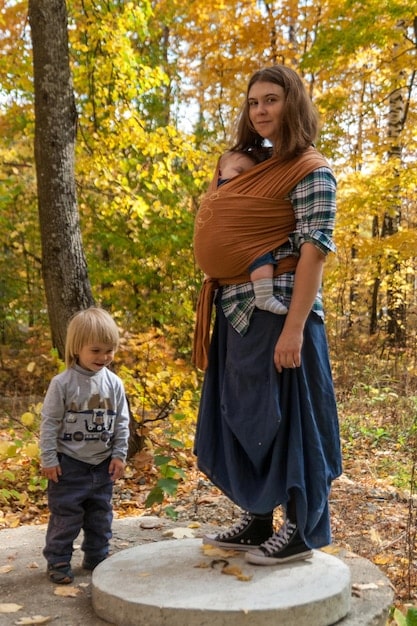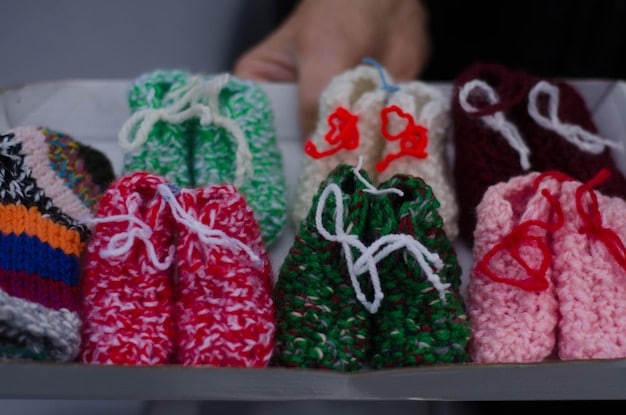Babywearing Benefits: Choosing the Best Carrier for You & Baby

Babywearing offers numerous benefits for both parents and infants, from enhancing bonding and facilitating breastfeeding to promoting infant development and providing parents with hands-free convenience; selecting the right carrier involves considering factors like baby’s age, carrier style, and personal comfort.
Discover the invaluable benefits of babywearing and learn how to choose the perfect carrier to keep your baby close, comfortable, and secure.
The Undeniable Benefits of Babywearing
Babywearing, the practice of carrying your baby in a sling, wrap, or carrier, has been around for centuries. Beyond convenience, it offers a multitude of benefits for both you and your little one.
From promoting bonding and easing colic to freeing up your hands, babywearing can make those precious early months even more enjoyable.
Enhanced Bonding and Attachment
One of the most significant babywearing benefits is the close physical contact it provides. This closeness stimulates the release of oxytocin, the “love hormone,” in both parent and baby.
This hormone promotes feelings of love, connection, and security, strengthening the bond between you and your child.
Reduced Crying and Colic
Studies have shown that babies who are worn regularly cry less. The constant motion and close proximity to the parent can be incredibly soothing, helping to ease colic and fussiness.
The upright position can also aid in digestion and reduce reflux symptoms.
- Regulates baby’s breathing and heart rate.
- Provides a sense of security and comfort.
- Eases digestive discomfort in infants.
- Promotes better sleep for the baby.
Babywearing provides numerous benefits that can improve your and your baby’s lives. It is a great way to stay focused on the important things while keeping physical closeness with your baby.
Understanding Different Types of Baby Carriers

With so many options available, choosing the right baby carrier can feel overwhelming. Understanding the different types and their unique features is the first step in finding the perfect fit for you and your baby.
Each type offers its own advantages and disadvantages, so consider your lifestyle, preferences, and baby’s age and development when making your decision.
Wraps
Wraps are long pieces of fabric that are tied around your body to create a pouch for your baby. They come in various materials, including woven and stretchy knits.
Stretchy wraps are best suited for newborns, while woven wraps are more versatile and can be used as your baby grows.
Slings
Slings are a single piece of fabric that goes over one shoulder and across your torso, creating a pocket for your baby. They are often made from soft, breathable materials and are relatively easy to use.
Slings come in different styles, including ring slings and pouch slings.
Soft-Structured Carriers (SSCs)
SSCs are perhaps the most popular type of baby carrier. They consist of a padded body panel, shoulder straps, and a waist belt. SSCs are easy to adjust and offer excellent support for both you and your baby.
They are a good option for longer periods of babywearing and can be used from infancy through toddlerhood.
- Wraps offer versatility in carrying positions.
- Slings are quick and easy to put on.
- SSCs provide excellent support and comfort.
- Framed backpack carriers are ideal for hiking.
Finding the right type of carrier is an important step in practicing babywearing. Considering the different types of carriers is the first step in choosing the right one for you.
Factors to Consider When Choosing a Carrier
Choosing a baby carrier should not be done without any thought. There are many factors that you should weigh when making the decision to make sure you are making the best one for you and your baby.
Make sure to keep the needs of both yourself and baby in mind during this process.
Baby’s Age and Weight
The first thing to consider is your baby’s age and weight. Some carriers are designed specifically for newborns, while others are better suited for older babies and toddlers.
Always check the manufacturer’s weight and age recommendations before using a carrier.
Carrier Comfort and Adjustability
Your comfort is just as important as your baby’s. Look for a carrier with padded shoulder straps and a supportive waist belt. Adjustability is key to ensuring a comfortable and secure fit.
Try on different carriers before making a purchase to see what feels best for you.
Ease of Use
A carrier that is easy to put on and take off will be much more likely to be used. Consider how quickly you can get your baby in and out of the carrier, especially if you’ll be using it frequently.
Some carriers require more practice and effort than others.

- Infant age and weight influence carrier suitability.
- Consider the carrier’s material and breathability.
- Ease of cleaning and maintenance matters.
- Determine the positions you wish to carry in.
Choosing the right carrier involves different factors that must be considered. This will ensure the safety of the baby and the peace of mind of the parent.
Safety Tips for Babywearing
While babywearing offers many wonderful benefits, it’s crucial to prioritize safety to protect your little one.
Following safe babywearing practices and being aware of potential hazards will help you enjoy this experience with peace of mind.
The TICKS Rule
The TICKS rule is a helpful acronym to remember the key safety guidelines for babywearing:
- Tight: The carrier should be snug against your body.
- In view at all times: You should always be able to see your baby’s face.
- Close enough to kiss: Your baby’s head should be close enough for you to easily kiss.
- Keep chin off chest: Ensure your baby’s chin is not resting on their chest, which can restrict breathing.
- Supported back: The carrier should support your baby’s back in a natural, upright position.
Monitor Your Baby’s Breathing
Regularly check on your baby’s breathing to ensure they are comfortable and not restricted. Watch for signs of distress, such as wheezing or difficulty breathing.
If your baby is a newborn, pay extra attention to their positioning and airway.
Be Aware of Potential Hazards
Be mindful of your surroundings and avoid activities that could be dangerous while babywearing, such as cooking, using the stove, or drinking hot liquids.
Avoid wearing your baby in situations where they could be bumped or jostled, such as in crowded areas or while participating in sports.
Prioritizing safety includes things such as watching for the TICKS rule and making sure baby is breathing properly. These things will ensure the baby’s safety while babywearing.
Babywearing Positions and Their Benefits
Many different methods exist to carry your baby while babywearing. The method you choose will depend on your comfort and how you’d like the baby.
Newborns have to be carried in a specific position that helps their breathing but toddlers can be carried on the hip.
Front Carry (Inward Facing)
This position is ideal for newborns and young infants. It allows you to keep a close eye on your baby and provides maximum support and comfort.
It also promotes bonding and allows your baby to hear your heartbeat, which can be very soothing.
Hip Carry
The hip carry position is great for older babies who have good head control. It allows them to see the world around them while still being close to you.
It’s also a comfortable position for nursing.
Back Carry
The back carry position is best suited for older babies and toddlers who can sit up independently. It frees up your hands and allows you to carry your baby for longer periods of time.
SSCs and framed backpack carriers are ideal for back carries.
- The inward-facing carry suits newborns.
- The hip carry works well for older infants.
- Back carries are best for older babies.
- Outward-facing carries can provide stimulation.
How you chose to carry your baby is an important factor in babywearing. Making sure to keep the baby safe and happy helps the experience.
Tips for Comfortable and Successful Babywearing
Babywearing is most enjoyable when done comfortably and safely.
By following these tips, you can ensure a positive and rewarding experience for both you and your baby.
Start Slowly
If you’re new to babywearing, start with short periods of time and gradually increase the duration as you and your baby get more comfortable.
This will allow you to adjust to the carrier and get used to the feeling of wearing your baby.
Dress Appropriately
Dress your baby in lightweight clothing, as they will be close to your body and may get warm. Avoid overdressing them, especially in warm weather.
Also, be mindful of your own clothing choices to ensure you are both comfortable.
Practice Makes Perfect
Don’t be discouraged if you don’t get it right away. Babywearing takes practice, and it may take a few tries to find the right fit and position.
Watch videos, read tutorials, and ask for help from experienced babywearers.
Being successful in babywearing happens when you practice it properly. Take time to get comfortable with babywearing to ensure you can practice it correctly.
| Key Point | Brief Description |
|---|---|
| 👶 Bonding | Enhances the parent-child connection. |
| 🙌 Hands-Free | Allows parents to perform tasks while holding the baby. |
| ✅ Safety | Ensuring the well-being of the baby. |
| 🧑⚕️ Baby’s health | Monitor the baby’s safety and health during babywearing. |
Frequently Asked Questions
▼
Babywearing promotes bonding, reduces crying, offers hands-free convenience, and supports infant development.
▼
Consider your baby’s age, carrier type, comfort, and ease of use when choosing a carrier.
▼
TICKS stands for Tight, In view at all times, Close enough to kiss, Keep chin off chest, and Supported back.
▼
Common positions include front carry, hip carry, and back carry, each suitable for different ages and comfort levels.
▼
Start slowly, dress appropriately, and practice regularly to find the right fit and position for you and your baby.
Conclusion
Babywearing can be an incredibly rewarding experience for both parents and babies. By understanding the benefits, choosing the right carrier, and following safety guidelines, you can enjoy the closeness, convenience, and developmental advantages that babywearing offers. Embrace this beautiful way to connect with your little one and create lasting memories.





